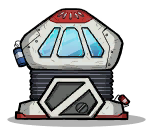ONI Rocket Calculator
Select engine
Select extra modules



Pick Oxidizer
Distance
Fuel required
(Click for sourcing options)Other modules
(Automatically optimized, but adjustable)


Ship stats
Acheivable distance vs. Fuel
Some explanation
Quick use guide
- Pick you main engine
- Pick your extra components (all cargo bay types are the same)
- Pick your oxidizer
- Select your desired distance and see how much fuel you require.
Assumptions:
- You put in the exact same amount of oxidizer as fuel for your main engine.
- Solid boosters are always 100% filled
- You can only have one type of main engine oxidizer (you can not be half LOX and half oxylite for example)
Issues and suggestions?
All suggestions are welcome. Please post issues or suggestions below in the discussion.
Fuels and weight penalty:
There are three fuels for each of the three base engines, each has its own "efficiency" in terms of km achieved per kg used:
- Steam 20km/kg
- Petroleum 40km/kg
- Liquid Hydrogen 60km/kg
The efficiency of a fuel is important since its a linear relationship between kg of fuel used and distance traveled, however the weight penalty is non-linear (credit to neoazureus):
Pentality = Max[Shipweight, (Shipweight/300)^3.2]The key take away is that every kg you add to your ship costs more than the last in terms of achievable distance. This is a nice mechanic that prevent mega rockets ever making sense as the additional weight costs too much distance.
Oxidizers
Importantly, engines (except steam) require an oxidizer now in a 1-to-1 ratio with the fuel in order to burn. Oxylite has a burn efficiency of 100%, Liquid oxygen has an efficiency of 133%, this would give for example Petroleum the power of 40km/kg and 53.2km/kg respectively.
Fuel/Oxidizer Storage
- Liquid fuel storage, weight 100kg, can carry 900kg of fuel
- Liquid oxydizer tank, weight 100kg, can carry 2700kg of oxydizer
- Solid oxydizer tank, weight 100kg, can carry 2700kg of oxydizer
Storage containers weigh very little. Interestingly, the oxidizer storage carriers exactly enough to burn 3 full fuel storage containers of fuel. So either you build a ship with 3 fuel tanks per oxidizer tank, or measure/limit the amount of oxidizer you pump in on smaller ships.
Quick math test of everything so far
Seeing the difference between petroleum and liquid hydrogen we can see that 3 tanks of petroleum will provide a base distance (before weight penalty) of 108,000km. (40km/kg * 2700kg). This is the same distance provided by only 2 full tanks of hydrogen (60km/kg * 1800kg). This distance would be boosted to 143,640 km if you use liquid oxygen instead of oxylite as the oxydizer.
This is significant since the mass of these two rockets would be totally different:
- Petroleum rocket: 6200kg (fuel 2700kg, oxidizer 2700, engine 200kg, capsule 200kg, fuel/oxy storage 400kg); Weight pentalty: -16,177km
- Hydrogen rocket: 4600kg (fuel 1800kg, oxidizer 1800kg, engine 500kg, capsule 200kg, fuel/oxy storage 300kg); Weight pentalty: -6,200km(ish)
So despite having the same base achievable distance, the net distance after weight penalty is 10,000km more for the hydrogen example.
Extra components
Whilst all the base rocket parts like fuel storage, engines and command capsule are all relatively light. All the other rocket components are relatively heavy and will balloon your weight penalty rapidly:
- Cargo bay: 2000kg
- Liquid cargo bay: 2000kg
- Gas cargo bay: 2000kg
- Sightseeing: 200kg
- Research station: 200kg
For example, even adding on just one of these cargo bays to the petroleum rocket above drives the weight penalty up to -39,575km (23k more) and a second takes it to -79,567km (40k more), so it will barely get off the ground.
The solid booster
The solid fuel thruster is an interesting item, whilst it add 12,000 base distance. It weighs 200kg and requires another 800kg in wet mass (400kg fuel, 400kg oxydizer) to be powered. The solid booster is not always a good choice, you can see its effects with the calculator. Generally if your ship already weighs 7000kg wet (including fuel) adding a solid booster begins to reduce the net achievable distance. It's generally most useful as a small bump to steam engines to bring back materials from early planets.
Discussion, questions and feedback
Oni Assistant is a place for learning and sharing ideas. If you think this page could be improved please let us know. If fellow users have questions, please be kind and helpful in your answers.
If you like using Oni Assistant and want to give back, the best way is to link it on your forums and socials.
K
To save your bandwidth, comments don't load automatically. Click the button below to view and provide comments.
Show Comments